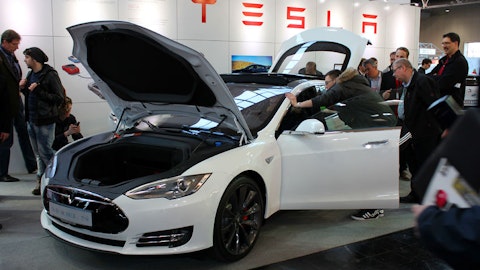Dennis Lu: Hey, Tim, this is Dennis. I just want to supplement one point regarding your question on the short-term borrowing. Yes, you are right we have increased our short-term borrowing in the third quarter. The reason is basically for the kind of the money management because we have established considerable credit lines with a variety of banks. And then we tactically draw down some part of the credit lines to strengthen the relationship with banks. So that’s why you see a slight increase in the short-term borrowing at the end of September.
Tim Hsiao: Great. Thank you very much for sharing Dennis and Brian.
Alex Xie: Hi, this is Alex. I just like to clarify, when Brian mentioned the decrease of SG&A expenses, it means like as a percentage of revenues in 2023 compared with as a percentage of revenues in 2022. Thank you.
Tim Hsiao: Okay, thank you.
Operator: Thank you. We have next question from the line of Ming-Hsun Lee with Bank of America. Please go ahead.
Ming-Hsun Lee: My question is that the ASP trend in 4Q based on the difference between your volume guidance and also the revenue guidance. So could you give us a more color on this? And besides that, looking into 2023, what’s your plan to control the component costs as well as the battery costs in order to maintain your gross margin? Thank you.
Dennis Lu: Ming, this is Dennis. Regarding your question on the ASP, yes, you’re right, in the third quarter, our ASP increased primarily €“ compared with quarter two, primarily due to the better mixed P7 mentioned also improved the margin. For the quarter four, the P7 €“ in terms of P7 mix will be lower. However, because of the mass delivery of the G9, so we will be able to maintain together the P7 and the G9 mix at about maybe 55% to 60%. So we should €“ we actually will have slight increase in terms of ASP compared with the quarter three, offsetting some variable marketing spending on the P5 and G3. So that’s the answer to your first question. In terms of material cost increase. So far, we haven’t seen the big changes in terms of the battery cost for the next year, mainly for the first quarter.
But we believe due to more supply, we are seeing opportunities in terms of the battery supply. And that would, in return, translate into a cost reduction maybe in the second half. So with that, the cost improvement will help to maintain or to improve our margin, offsetting the NEV subsidy discontinuation.
Brian Gu: Yes. So Ming, just to also add to this, the fourth quarter, due to the volume contraction and also launching of our new product, G9, I think the gross profit will face some pressure versus the third quarter and then the first quarter, given the subsidy elimination, which impacts some of our lower-priced models, so that will also present a challenge for the gross profit. However, our view is that with the volume rebounding starting in the second quarter and in the rest of the year with scale, and also, we anticipate battery prices moderate and also show some opportunities for decline later in the year, I think the gross profit trend will improve significantly in the later half of next year.
Ming-Hsun Lee: Okay. Thank you, Brian and Dennis. I have no questions.
Operator: Thank you. We have next question from the line of Nick Lai with JPMorgan. Please go ahead.
Nick Lai: Now let me translate my question firstly. Now Chairman just mentioned that you are going to change a lot of strategy regarding the management, including branding and marketing team and can you elaborate more what are going to change in terms of branding strategy and marketing campaign? And what €“ when can we expect those changes having an impact on underlying demand or volume?
He Xiaopeng: Alright. Thank you, Nick, for your question. We’re actually conducting or in the midst of doing this organizational adjustment with focus on our branding and marketing. Looking back, I mean in the past, our branding and sales and marketing mainly focused on sales with more focus on boosting the sales of our products, but going into the future, we are going to balance different aspects of our branding, marketing and sales with innovative measures, and we plan to actually reduce our spending to boost in the sales, while increasing our spending in marketing. Now, the second thing that is regarding the organization adjustment is that we plan to €“ we expect to integrate our organization to make it more efficient and effective.
And we plan to recruit very high-quality talent from different industries in order to boost our sales and marketing efficiency and we aim to launch a series of measures in order to tackle different challenges as well as boost our effectiveness in order to align our product portfolio as well as to achieve higher customer satisfaction rate, while adjusting the customer demand. Now, we are talking about our near-term strategy for these organizational changes in the coming 15 months, but we believe that in the long run, we will continue such adjustment in order to achieve our mid to long-term goal. Thank you. And just allow me to add several key points. The first one is that we will have a clearer positioning of our brands and products. And the second thing is that we are aiming for the long game.
We are not doing this for the short-term. And the third point is that we are going to be more aggressive and more proactive in our sales and marketing campaigns rather than being rather passive just like in the past. And the fourth and the last point is that we will remain a very customer-oriented and focused. Thank you.





